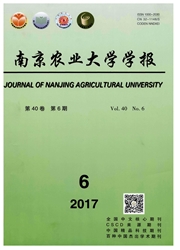

 中文摘要:
中文摘要:
[目的]本试验旨在探讨富硒乳酸菌(SL)对四氯化碳(CCl4)诱导肝脏纤维化大鼠的保护作用。[方法]首先制备富硒乳酸菌,然后用CCl4诱导建立大鼠慢性肝损伤模型。应用HE染色、天狼星红染色进行病理分析,应用自动生化分析仪测定大鼠血清中丙氨酸氨基转移酶(ALT)和天冬氨酸氨基转移酶(AST)的活性,通过Real-time PCR法测定Ⅰ型胶原蛋白(CollagenⅠ)、α-平滑肌蛋白(α-SMA)及炎症相关基因的表达水平。[结果]SL显著降低了CCl4诱导肝纤维化大鼠的血清ALT(87.3 U·L^-1)、AST(98 U·L^-1)活性和MDA(2.42 nmol·mg^-1)含量(P〈0.05),但增加了GSH-Px(37.9 U·mg^-1)、SOD(202U·mg^-1)活性和GSH(3.36 mg·g^-1)含量(P〈0.05)。SL抑制了CCl4诱导的肝脏炎症和坏死。此外,SL显著降低了CCl4诱导肝损伤大鼠的α-SMA、CollagenⅠ、转化生长因子(TGF-β1)、基质金属蛋白酶抑制剂(TIMP-1)及炎症相关基因的表达(P〈0.05)。[结论]SL通过缓解肝脏氧化应激,降低肝内炎症反应来保护CCl4诱导的肝脏纤维化。
 英文摘要:
英文摘要:
[Objectives] The aim of this study was to investigate the effects of selenium-enriched lactobacillus (SL) on the liver fibrosis induced by CCl4 in rats.[Methods] First,the selenium-enriched lactobacillus were prepared,then the rat model of chronic liver injury was established. The liver pathological condition was analyzed by HE staining and Sirus red stain. The activities of ALT and AST in the rat serum was determined by automatic biochemical analyzer. The expressions of CollagenⅠ,α-SMA and inflammation-related genes were determined by Real-time PCR.[Results] SL significantly decreased serum ALT(87.3 U·L^-1),AST(98 U·L^-1) activities and MDA(2.42 nmol·mg-1) content(P〈0.05),but increased GSH-Px(37.9 U·mg^-1),SOD(202 U·mg^-1) activities and GSH(3.36 mg·g-1) content(P〈0.05) in rats treated with CCl4. SL suppressed hepatic inflammation and necrosis induced by CCl4. Moreover,SL significantly reduced the expressions of α-smooth muscle actin(α-SMA),CollagenⅠ,TGF-β1,TIMP-1,and inflammation-related genes(P〈0.05) in rats treated with CCl4.[Conclusions] SL could protect the liver from carbon tetrachloride-induced liver fibrosis by attenuating hepatic oxidative stress and suppressing hepatic inflammation.
 同期刊论文项目
同期刊论文项目
 同项目期刊论文
同项目期刊论文
 期刊信息
期刊信息
